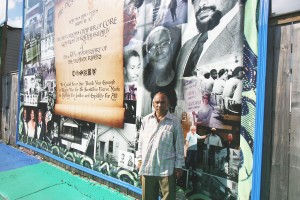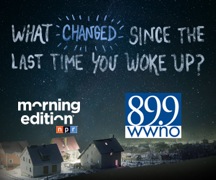Black Men of Labor to honor the Freedom Riders
31st October 2011 · 0 Comments
By Geraldine Wyckoff
Contributing Writer
Driving or walking down St. Claude Avenue, the area around Sweet Lorraine’s jazz club immediately jumps out at you. The first thing one spots is the telephone poles decorated in green fringes that could be described as hula skirts blowing in the breeze. The nightspot and home of the Black Men of Labor, the highly regarded parading and cultural institution, spruces up each year in preparation for the organization’s annual parade. This year, however, there is an added element that has created a major buzz. People have been asking, “Have you seen the mural at Sweet Lorraine’s?”
 On the wall of an adjoining building hangs a magnificent 30’ x 20’ mural that pays tribute to the 50th anniversary of the Freedom Riders and the members of the New Orleans Chapter of the Congress for Racial Equality (CORE) to whom the Black Men of Labor (BMOL) parade is dedicated. The piece is a collage of photographs, primarily shots of local activists and scenes from the civil rights era, overlaid with a proclamation of the BMOL organization’s intent.
On the wall of an adjoining building hangs a magnificent 30’ x 20’ mural that pays tribute to the 50th anniversary of the Freedom Riders and the members of the New Orleans Chapter of the Congress for Racial Equality (CORE) to whom the Black Men of Labor (BMOL) parade is dedicated. The piece is a collage of photographs, primarily shots of local activists and scenes from the civil rights era, overlaid with a proclamation of the BMOL organization’s intent.
“Primarily, since it is the 50th anniversary, we wanted to make certain that we reached out and said thank you for the dues they paid,” says Fred Johnson, a founding member of the BMOL. “These men and women fought, bled and died so that people could have equal rights and justice. A lot of accomplishments that have taken place today are on the shoulders of people like this and the the history books don’t tell that story. These are everyday people who were walking around here that fought not just to change New Orleans but to change America.”
Johnson feels that few people recognize the important place that many members in the New Orleans chapter of CORE held during the civil rights movement. “A lot of people don’t know that the New Orleans chapter was very instrumental in giving direction to the rest of the country. They stepped up, they weren’t afraid and if they were, they went on anyway.”
Prominent in the collage is a group of mug shots of New Orleanians, both men and women, who were arrested in Mississippi there having traveled there to fight against segregation. Their names are not generally well-known, though their efforts helped change history.
“It seems like Mississippi is where they got the harshest treatment given the level of racism,” Johnson notes. “ That’s where they were jailed. Some of them even went to the penitentiary. They didn’t just go to the local jail.”
Others of those whose pictures don the mural are more widely known in the New Orleans community at large either by their past and present work or perhaps merely because streets and schools bear their names. Oretha Castle Haley’s image graces the wall as well as two photographs of her parents’ home at 917 N. Tonti. Johnson explains that the home was known as the “Freedom House,” as her parents made it available to all the local civil rights workers as well as activists who would travel to New Orleans. Other familiar names include the Rev. Avery Alexander, A.L Davis, Rudy Lombard and Doratha “Dodie” Smith-Simmons.
“Everybody on here had some role that, in one way or another, would change the direction of America when it came to racism and desegregation,” Johnson proudly declares. He points out the photo of a man who could be deemed one of many unsung heroes. Matt “Flukie” Suarez took on the formidable task of driving protesters to their destinations. Then there were the lawyers who were required to handle legal problems. Attorneys Robert Collins, Lolis Elie and Neals Douglas were partners in the law firm that represented the Freedom Riders and garnered their release from a Mississippi jail.
Many of the photographs depict civil rights workers picketing on Canal Street at spots like Woolworth’s, the Kress department store and McCrory’s. The messages on the signs said not to patronize these businesses because they discriminated against Blacks.
“If you stop their money from moving, they’ll figure out how to make a judgment because in a capitalist society the money has to keep moving,” Johnson notes. “The non-violent approach effects economics in most instances and economics is what the system respects.”
The lack of equal access to transportation — buses, streetcars, trains — was another high-profile issue that is pictorially addressed on the mural. “Jerome Smith and Don Hubbard had a chance to move a board,” says Johnson speaking of the board that indicated the section in the back of the bus where Blacks were forced to sit. “There were quite a few people who were just aggravated and frustrated with it but they knew the serious consequences. It wasn’t a slap on the hand, you could lose your life just for moving one. We’ve come a long ways and we still have a long way to go. There’s still too much racism and it’s tied to economics. Economics is what forces crime because people resort to illegal things.
“What this is about is to educate the viewing public who comes to the BMOL parade and say look at this and remember where we come from,” Johnson continues.
Being a non-profit organization, the Black Men of Labor’s charter doesn’t allow it to take a political stand in the strict sense of the word though it maintains an active voice when necessary.
“If you’re going to say political, it’s not from a popular politics standpoint, it would be political from a cultural standpoint in terms of not letting all of our rich traditions get away,” Johnson explains. The Black Men of Labor’s mission is to keep traditional brass band music on the street. We try to stay conscious about what’s going on around us without being overly zealous or overly political. If we have to raise our voice and make a statement about something that will affect the culture, sure we do.”
Since forming in 1994, the Black Men of Labor have celebrated various honorees and themes at their annual parades. Only a few have been in such grand fashion or as significant in topic as this year’s tribute to the Freedom Riders.
“We feel that since we’re responsible for what we know and we know it’s the 50th year then we should step up and do what we’re supposed to do,” Johnson declares. “For us we couldn’t stand to miss the opportunity to say thank you and the best way we knew how was with traditional brass band music.”
This article was originally published in the October 31, 2011 print edition of The Louisiana Weekly newspaper



